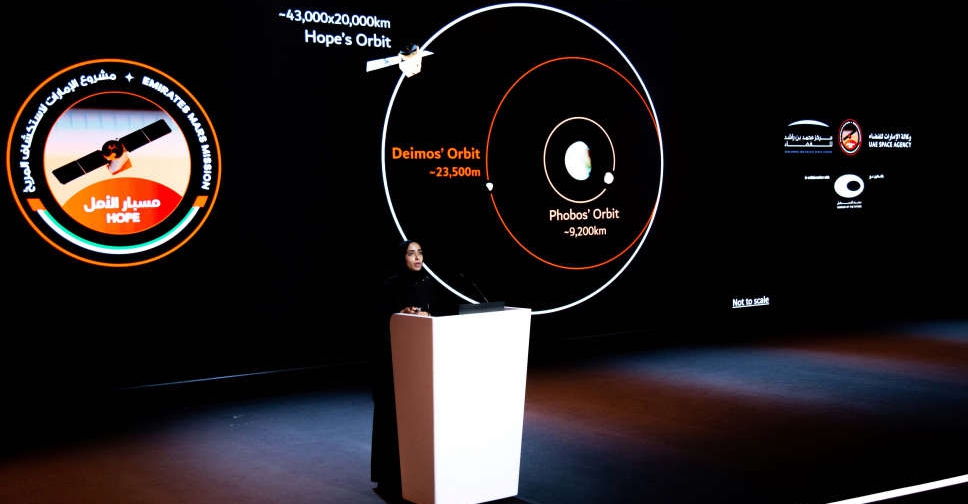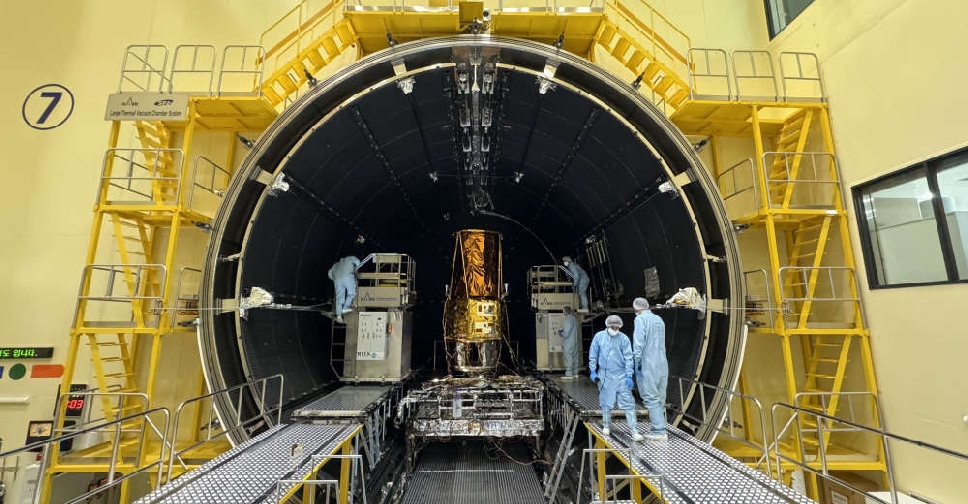
After two years of orbiting Mars, the UAE's Hope Probe is now gearing up to capture unprecedented data about Deimos, one of the Red Planet's lesser-observed moons.
The first Arab-led planetary exploration mission is transitioning to a new orbit, which will allow the Hope Probe to fly within approximately 150 km on Deimos, which is the smaller and outermost of the two natural satellites of Mars.
The new historical move will allow the Hope Probe to transition into a new elliptic orbit around Mars, following a Lambert orbital transfer maneuver utilizing the change in its velocity.
In addition to gathering data on Deimos, the Probe will continue its original mission and capture data on Mars’ atmosphere.
Deimos is the least observed compared to the red planet’s second moon, Phobos, which has been widely observed since its discovery in 1969.
Orbiting Mars on a larger orbit, Deimos completes a revolution around the planet every 30 hours.
"The deimos campaign aims to provide the international scientific community with previously unseen observations and data. The Hope Probe will capture high cadence images and data of the irregularly shaped, crater-heavy moon, during fly-bys at different times," said Eng. Hessa Al Matroushi, Emirates Mars Mission Science Lead.
The Hope Probe’s journey of exploring new frontiers continue. The Arab world’s first interplanetary mission began minor maneuvers towards Deimos and capture unprecedented data about one of Mars' lesser-observed moons. pic.twitter.com/RjcZmz1nw1
— Hope Mars Mission (@HopeMarsMission) February 9, 2023
The first Deimos fly-by began late January and continues through February 2023, as the Probe moves to its closet approach to the moon, which allows the Probe’s Emirates Exploration Imager (EXI), Emirates Mars Ultraviolet Spectrometer (EMUS), and the Emirates Mars Infrared Spectrometer (EMUS), to capture high cadence images and detailed observations of the moon.
To enable the orbital transfer maneuver, the Hope Probe completed two out of three maneuvers using its main thrusters in September 2022 and January 2023, marking the first time the thrusters were activated remotely to make the necessary orbital corrections.
The Hope Probe orbits Mars is currently in its elliptic orbit between 20,000 and 43,000 km with a 25-degree incline towards the planet, giving it the unique ability to complete one revolution around the planet every 55 hours, capturing comprehensive data every nine days.
The slight change in the Probe’s orbit will allow it to capture new observations of Deimos, while capturing data on the red planet’s atmosphere.
The Hope Probe is the culmination of the national space sector's development and knowledge transfer efforts, which began in 2006.
Emirati engineers collaborated with international partners to design and develop the UAE's space crafts and national manufacturing and engineering capabilities.
The Probe is equipped with three measurement tools to analyze Mars’ atmosphere.
Weighing 1350 Kg, equal to a small SUV, the Probe was designed and developed by the engineers of Mohammed Bin Rashid Space Centre, in cooperation with partners from leading international academic institutions, including the Laboratory of Atmospheric & Space Physics, University of Colorado Boulder, Space Sciences Laboratory (SSL), University of California, Berkeley, and Arizona State University (ASU).
The Emirates Mars Mission issued six batches of data on the red planet. The first batch size was 110 Gigabytes and was released on 1 October 2021, while the second batch size was 76.5 Gigabyte and was released on 12 January, 2022.
The 57-Gigabyte third batch of data was announced on 1 April 2022, while the fourth batch offered 118.5 Gigabytes of data. The fifth batch of data provided the scientific community with 236.8 Gigabyte of data.
The sixth batch of data offered several observations, which were captured by the Probe’s Emirates Mars Ultraviolet Spectrometer (EMUS), and the Emirates Mars Infrared Spectrometer (EMIRS), while the Emirates Exploration Imager (EXI) captured high cadence images of high dust movement on Mars, on 6 June, 13 June, 22 June, 27 June, 13 July, 22 July, and 12 August, 2022.
A series of EXI color composites taken over about six hours on the 24th of September revealed a massive dust storm and dense fog covering Valles Marineris and the surrounding areas from early morning hours until noon, as well as the rapid evolution of the storm.

 UAE's MBZ-SAT set to launch from the United States
UAE's MBZ-SAT set to launch from the United States
 Kazakh President arrives in UAE on working visit
Kazakh President arrives in UAE on working visit
 H.H. Sheikh Mohammed, Malaysian PM explore new avenues for collaboration
H.H. Sheikh Mohammed, Malaysian PM explore new avenues for collaboration
 'UAE stands with Lebanon' campaign concludes on high note
'UAE stands with Lebanon' campaign concludes on high note
